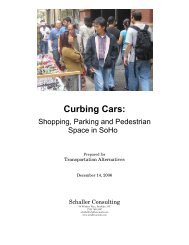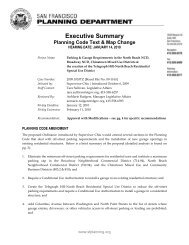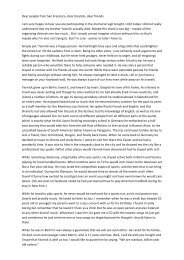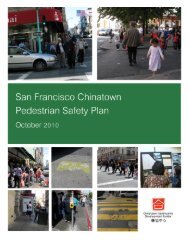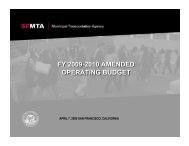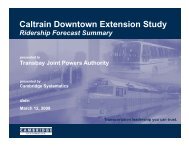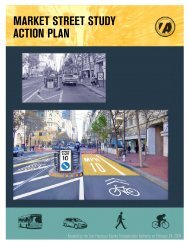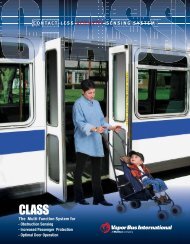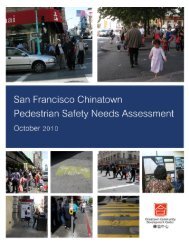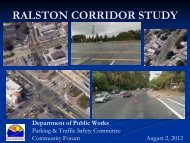Alternatives To Auto LOS For Impact Analysis 111505
Alternatives To Auto LOS For Impact Analysis 111505
Alternatives To Auto LOS For Impact Analysis 111505
Create successful ePaper yourself
Turn your PDF publications into a flip-book with our unique Google optimized e-Paper software.
Hiatt 5<br />
Though auto <strong>LOS</strong> provides valuable information for planning purposes, it does not meet<br />
the needs of urban multimodal areas when used as a legal standard to define the adequacy of<br />
transportation facilities.<br />
Reinforcing the Incumbent Mode<br />
Strict standards for auto <strong>LOS</strong> can make infill development and improvements to modes other<br />
than the auto difficult, particularly on mature street networks where roadway space is<br />
constrained. San Francisco’s next generation of transportation improvements to transit,<br />
pedestrian, and bicycle facilities will require reallocating roadway space from mixed traffic uses<br />
to pedestrian, bicycle, or transit use, sometimes worsening auto <strong>LOS</strong> (14). Consequently, using<br />
auto <strong>LOS</strong> as the standard for roadway adequacy ostensibly favors preserving auto <strong>LOS</strong> at the<br />
expense of improvements to transit, bicycle, and pedestrian conditions.<br />
Discouraging Multimodal Improvements<br />
In San Francisco, a proposed project with impacts forecast to worsen <strong>LOS</strong> to grade “E” or “F”<br />
must typically either: 1) mitigate the impact by reducing auto delay; 2) modify the project to<br />
reduce auto delay; or 3) the project is denied approval. Although projects with unmitigatible<br />
significant negative impacts may nevertheless be approved by elected officials through a<br />
declaration of overriding considerations, the project sponsor must complete the costly and<br />
unpredictable impact assessment process. Project sponsors may therefore be reluctant to<br />
propose projects that potentially impact auto <strong>LOS</strong>.<br />
Avoiding “Difficult” Multimodal Projects<br />
In practice, proposed bicycle or transit lanes that would remove a lane of auto traffic are<br />
considered to have significant negative environmental effects since removing a lane of auto<br />
traffic often worsens auto <strong>LOS</strong>. Moreover, it is often difficult to identify mitigations that restore<br />
auto <strong>LOS</strong> while preserving the spirit of the project to improve conditions for transit, bicycling, or<br />
walking.<br />
The City of San Francisco has attempted to minimize the burden of environmental review<br />
process within the constraints of current <strong>LOS</strong> standards. These strategies include implementing<br />
bicycle projects as “trials” before undertaking the environmental process and earning final<br />
project approval. This is only feasible when the project in question is “reversible” in the event<br />
that auto <strong>LOS</strong> impacts are unacceptable (e.g., projects which involve primarily re-striping).<br />
Because San Francisco has a mature road network and finite public rights-of-way, it is<br />
easy to assume a priori that many bicycle, pedestrian, and transit improvements cannot be<br />
implemented without significantly impacting auto <strong>LOS</strong>. But, an increasing body of research<br />
shows that when vehicle capacity is reduced, trip patterns have adjust in terms of absolute<br />
vehicle trips or the time and route of trips. This is especially so when alternative modes and<br />
routes are available. However, it is easy to suspect that projects don’t move beyond the<br />
conceptual phase because from the project sponsor perspective, lane removal functions as a “de<br />
facto” rejection criterion because removal of a traffic lane usually decreases auto <strong>LOS</strong>.<br />
<strong>Auto</strong>-Oriented Mitigation Measures<br />
Maintaining <strong>LOS</strong> affects local transportation investments. CEQA and other growth management<br />
rules allow for project sponsors to make project changes that “mitigate” the impacts of the<br />
project on <strong>LOS</strong>. The proposed project may then be approved if it is timed to occur with<br />
mitigations that would preserve <strong>LOS</strong> at adopted standards (8).




